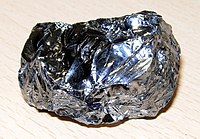
Photo from wikipedia
Off-resonance actuators utilizing lead-free incipient piezoelectric materials have recently gained extensive attention because of their exceptionally high electromechanical strain. However, current incipient piezoelectric materials have three critical challenges, namely, high… Click to show full abstract
Off-resonance actuators utilizing lead-free incipient piezoelectric materials have recently gained extensive attention because of their exceptionally high electromechanical strain. However, current incipient piezoelectric materials have three critical challenges, namely, high driving field required for producing potentially high strains, high frequency dependence, and relatively poor fatigue resistance, which seriously restrict the implementation of lead-free incipient piezoelectrics in high-efficiency actuator applications. Herein, we demonstrate that the integration of chemical engineering and crystallographic texturing design strategies into a Bi0.5Na0.5TiO3-based system provides a highly effective approach to address these challenges. Novel 〈00l〉-oriented 0.97(0.94Bi0.5Na0.5TiO3-0.06BaTiO3)-0.03NN, as an exemplary incipient piezoelectric ceramic, was fabricated to experimentally demonstrate this design concept. A low field-driven large strain response (∼0.32% at 50 kV cm-1, ∼0.46% at 75 kV cm-1), excellent frequency dependence (∼0.42% at 65 kV cm-1, <5% variation from 0.1 Hz to 100 Hz), and superior fatigue endurance (S > 0.4%, <10% change up to 105 cycles) were simultaneously achieved in the manufactured textured ceramic, which is superior to that reported previously in most lead-free perovskite ceramics. These outstanding actuator performances can be mainly ascribed to the considerably easy ergodic relaxor to ferroelectric phase transition due to the formation of an oriented microstructure, which promotes domain switching and mobility, as confirmed by PFM measurements. This study offers a feasible and reproducible design methodology, i.e., chemical engineering and crystallographic texturing, to develop viable incipient piezoceramics and will guide future efforts in this field.
Journal Title: Dalton transactions
Year Published: 2020
Link to full text (if available)
Share on Social Media: Sign Up to like & get
recommendations!